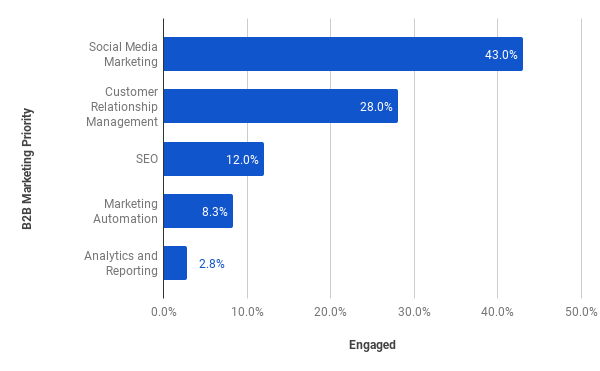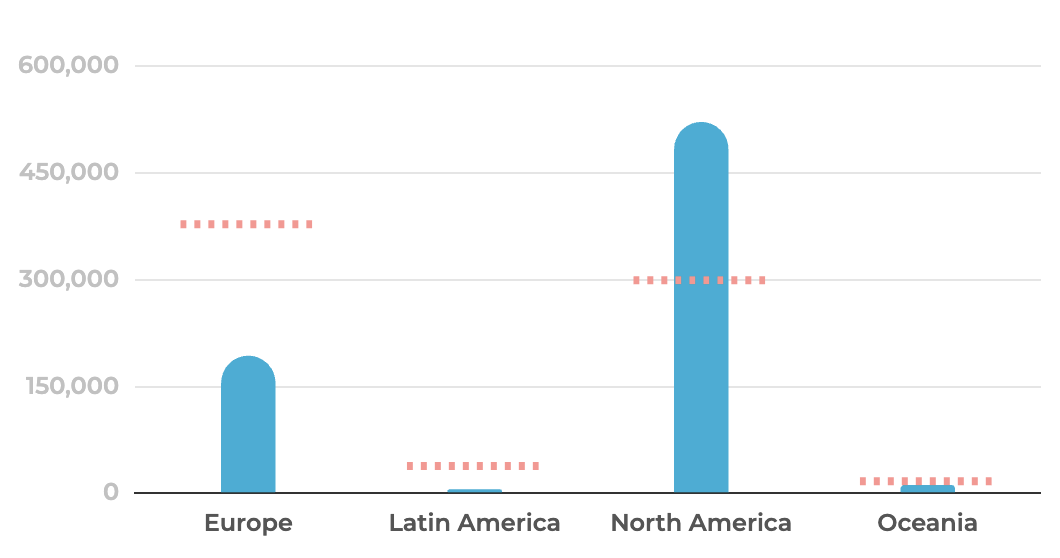B2B Marketing Priorities in 2024
B2B Stances By Worldwide Region
Discover what people think about marketing between businesses
Faced with various challenges that would have been difficult to foresee several years ago, B2B marketing continues to adapt and evolve. Rather than being a haphazard process, this ongoing evolution is guided by various trends that arise among consumers and the businesses catering to them. This branch of marketing is also guided by responses to some of the obstacles that B2B marketers encounter in the course of their work. Paying attention to current insights and statistics can also help fine-tune organisations’ and individuals’ business-to-business marketing efforts.
We’ve analysed global data from X, Reddit, and TikTok for 12 months up until 29th February 2024 with a sample size of 732,421 people to gain deeper insights into current perceptions of B2B marketing. We’ve looked at which demographics are most interested in this type of marketing and its importance for businesses on a worldwide scale.
Let’s dive into the data and see what it reveals about current attitudes towards marketing between businesses.
B2B Marketing Priorities in 2024
Business-to-business marketing exists within every industry in which businesses produce goods to supply to other businesses from which customers purchase those goods. While there are some differences in B2B stances in various regions, the basic purpose remains the same: to market a business’s products to other businesses. Opinions, stances, and practices around B2B marketing vary from region to region, with some focusing on different aspects to others.

Let’s unpack these various stances and practices.
1. 43% Of People Said That B2B Marketing Includes Social Media Marketing
Almost half (43%) agreed that B2B marketing includes social media marketing. Given the popularity of social media around the world, this figure is surprisingly low. However, it starts to make sense when we contextualise it: for the past few years, there has been a strong push for businesses to include social media in their marketing strategies, and the push is working.
According to Score, 77% of businesses use social media to reach customers, but this is usually in terms of B2C (business-to-customer) marketing. B2B marketing is still trying to catch up with the social media trend.
2. 28% Said B2B Marketing Is Essential For Customer Relationship Management
28% of people, or slightly more than a quarter, agreed that B2B marketing is essential for customer relationship management (CRM). This could indicate that more education and awareness-creation is necessary among B2B marketers, as B2B has a significant role to play in CRM. Statistics reveal that 84% of B2B buyers are more likely to choose a vendor with a clear understanding of their business objectives.
The relationship between B2B and CRM can be leveraged for enhanced lead generation. CRM plays a key role in helping to gather, organise, and analyse data around customer behaviours, needs, and preferences. The data that businesses gather can help them create personalised communication, targeted marketing campaigns, and tailored strategies, offerings, and messaging aimed at specific segments or individual customers.
3. 12% Said Search Engine Optimisation Is Important For B2B Marketing
Only 12% of individuals feel that search engine optimisation (SEO) is important for B2B marketing. This is not surprising, as SEO’s potential in this area appears to be untapped. A 2023 survey found that only 34% of B2B marketers said that SEO was responsible for most of their leads and sales.
Even though this statistic is relatively low, SEO still ranked higher than search engine marketing (30%), paid social media (29%), in-person tradeshows and events (27%), and content marketing (22%).
4. 8.3% Agreed That B2B Marketing Is Important For Marketing Automation
Looking at Polly’s data, we found that 8.3% of people agreed that B2B marketing is important for marketing automation. B2B marketing’s potential for marketing automation is another area that appears to be untapped. Judging by recent data, automation is quickly becoming the marketer’s best friend, with the global marketing automation market expected to reach $13.71 billion by 2030.
Statistics also show that 76% of companies use marketing automation, marketers who use automation are 46% more likely to have an effective marketing strategy, and automated emails generate 31% of email orders. However, one of the most impressive statistics is that 91% of marketers say that marketing automation helps them achieve their objectives.
There is a growing awareness of the link between B2B marketing and marketing automation, as seen from the 63% of B2B marketers who said they would increase their marketing automation budget in 2023/24 in another survey.
5. 2.8% Said Analytics And Reporting Are Important In B2B Marketing
2.8% of people consider analytics and reporting important in B2B marketing. This figure is surprisingly low, considering the importance of data analysis and reporting in B2B marketing. Analytics and reporting make it possible for businesses to identify trends, gain insights into customer behavior, measure their marketing activities’ impact, and optimise their marketing strategies.
However, B2B reporting is not without its challenges. YouGov research found that 56% of marketing leaders think that B2B marketing is more challenging than B2C marketing. This is due to the diverse data points across numerous challenges, bigger buying committees, and longer sales cycles. Another challenge in terms of B2B analytics and reporting is that most marketing platforms were designed with B2C marketing in mind, making them unsuitable for reporting on B2B marketing dynamics.
The figure of 2.8% might indicate that most B2B marketers might work around inadequate reporting rather than that most marketers believe that reporting and analytics aren’t important.
Changing Perceptions Of B2B Marketing
Polly’s data makes it clear that, while various demographics in various regions are contributing to the conversation around and understanding of B2B marketing in the face of various challenges, the conversation is being driven by a narrower group, mostly in the US. Polly also had a few other surprises in store when it came to demographics. Let’s dive in and explore age, gender, and region.
Which Age Demographic Contributed The Most To The B2B Marketing Conversation?
Various age groups had something to say about B2B marketing. Let’s take a look at which groups were the most vocal about it.

According to Polly, the age demographic most vocal about B2B marketing was 55-64. What’s more, this age group’s actual engagement, represented by the blue line, far outpaced the expected engagement level, represented by the red line.
The next two demographics that offered a high level of engagement were 45-54 and >65. The former group’s actual engagement was somewhat higher than expected, while the latter’s actual engagement was what was expected. The 35-44, 25-34, and <25 age groups were under-represented. None of these groups’ actual engagement levels achieved the expected levels of engagement.
Ranked from highest to lowest by response rate, Polly’s data indicates that individuals in the following age groups had the highest engagement on the topic of B2B marketing:
- 55-65 – 188k people
- 45-54 – 140k people
- >65 – 140k people
- 35-44 – 120k people
- <25 – 118k people
- 25-34 – 110k people
These figures show that individuals aged 55-65 were in the overwhelming majority when it came to engagement, although there were also good rates of engagement from people aged 45-54 and >65, whose rates were on par with one another.
However, these figures do not necessarily mean that these age groups are most represented among B2B marketers. Instead, they reveal the groups that contributed the most responses to the study. It may also be a case of younger demographics having more experience in general marketing rather than business-to-business.
Zippia data presents a slightly different picture when it comes to age groups, in that the most vocal according to Polly are not necessarily those who participate most in the labour force or in managerial roles. According to Zippia, the 35-44 age group has a 77% labor force participation rate, and Zapier revealed that 62% of the Millennials (ages 28-43) surveyed are in a managerial role.
We can fine-tune this with data from Marketing Week. According to Marketing Week’s 2024 Career and Salary Survey, 70.2% of marketers are in the 26-45 age group, 40.2% are in the 26-35 age group, 30% are in the 26-45 age group, 20.4% are in the 46-65 age group, and 8.6% are in the 18-25 age group.
B2B Marketing Engagement By Gender
In addition to age groups, Polly’s data also covered business-to-business marketing sentiments and stances by gender. Let’s see who had the most to say.

Polly’s data also showed a disparity in the rate of engagement by gender when it came to talking about B2B marketing. Males had a higher rate of engagement compared with females. This could be due to men reaching higher levels in marketing than women, even though in some regions, such as the UK, women comprise the bulk of the professional marketing population.
According to Polly’s data, significantly more men were vocal about B2B marketing. The actual rate of engagement (blue line) of men surpassed the expected rate (red line) by almost 50,000. Noticeably fewer women engaged in discussions about business-to-business marketing. Their actual rate of engagement (blue line) fell 60,000 short of the expected engagement rate (red line) of 380,000.
Ranking the greater responses first, Polly’s data revealed that the rate of engagement around B2B marketing by gender was:
- Male – 400K
- Female – 320K
A study of more than 1,300 marketing professionals in the UK found that 75% of them were women, while 25% were men. Despite women being in the clear majority, twice as many men (18%) reach director level, compared with 7% of women. This disparity is also evident in head of marketing roles. 25% of men reach this level, compared with 12% of women.
The study, conducted among more than 1,300 marketing professionals, found women make up 75% of the professional marketing population in the UK, yet more than twice as many men (18%) reach director level compared with women (7%).
It’s worth bearing in mind that these statistics might be slightly skewed in favour of B2C marketing professionals, as women traditionally have been underrepresented in the B2B marketing space. This underrepresentation isn’t limited to marketing in B2B. According to the Harvard Business Review, women also hold less than one-third of business-to-business sales positions.
This disparity of engagement by gender is sure to change in future, given the growing role of women in diverse business roles. According to McKinsey, the percentage of women in C-suite roles has grown by 6% over the last five years to reach 28%.
B2B Marketing Priorities By Region
As can be expected, people around the world continue to be part of the wider conversation around B2B on social media platforms. Let’s see what Polly found about the contributions made by different geographic regions.

Of the four regions from which Polly drew its data, North America was the most aware and engaged in conversations about B2B marketing, followed by Europe, Oceania, and Latin America. Africa and Asia were not considered. In terms of the number of people who shared B2B marketing insights by region, the data showed:
- North America – 500K
- Europe – 170K
- Oceania – 20K
- Latin America – 10K
North America was the only region in which the actual engagement rate (blue line) was greater than the expected (red line) rate. In this region, approximately 200,000 more people were vocal about B2B marketing. Every other region included in Polly’s data fell short of the expected rate of engagement. Europe’s approximate 170,000 individuals who added to the B2B conversation were significantly fewer than the expected 350,000 individuals, while Oceania’s 20,000 people were fewer than the 30,000 people expected to engage on the topic. The 10,000 Latin Americans who were vocal about business-to-business marketing fell short of the 35,000 people expected to contribute to the conversation.
These findings are somewhat consistent with recent survey findings by LinkedIn and Ipsos. In 2023, the two teamed up and surveyed 1,577 senior-level B2B marketing leaders and 377 CFOs in Australia, Brazil, France, Germany, India, Singapore, the United Kingdom, and the US. While the survey didn’t focus on the number of respondents per region, it did reveal various insights into approaches to B2B marketing in those regions. The survey found that, while B2B marketing budgets would increase in 2024 across all regions surveyed, the largest budget increase expectations were in the Asia-Pacific region (74%), followed by North America (66%), Latin America (65%), and Europe, the Middle East, and Africa (64%).
The survey also found that North America led the way in terms of the percentage of the B2B marketing budget that will be directed toward new customer acquisition (74%). 71% of the budget in Latin America and in Europe, the Middle East, and Africa, and 67% in Asia-Pacific will be directed toward the same.
North America also was ahead of the pack when it came to using artificial intelligence (AI) to gain a competitive advantage. According to the survey, 43% of B2B leaders in North America said they would use AI for this purpose, compared to 37% in Asia-Pacific, 32% in Latin America, and 32% in Europe, the Middle East, and Africa.
While Asia wasn’t included in Polly’s data, the Pacific region’s Oceania was, while data from the Middle East and Africa was included with data from Europe. Making allowances for these differences, the LinkedIn-Ipsos survey harmonises well with Polly’s findings, especially when it comes to North American approaches to B2B.
Diverse Opinions On B2B Marketing
While there was no clear majority regarding B2B marketing stances and practices, the strongest sentiment was that social media should be included. More than a quarter of sentiments analysed by Polly agreed that business-to-business marketing is important for customer relationship management. There were fewer agreements regarding B2B marketing and marketing automation, search engine optimisation, and reporting and analytics.
Of course, Polly’s breakdown of the various demographics makes it clear that these stances are not the final word on the subject. The demographics indicated that the most vocal groups were older men in the US, while women and younger age groups were underrepresented and African and Asian voices weren’t included at all. What we can deduce from Polly’s data is that B2B marketing continues to evolve regionally and globally.
About The Data
We created an independent sample of 732,421 people from Twitter, Reddit and TikTok worldwide over the past 12 months up to 29 February 2024. Responses were collected and analysed to produce outcomes within a 90% confidence interval and 5% margin of error. Engagement estimated how many people in the location are participating. Demographics were determined using many features, including name, location, and self-disclosed description. Privacy was preserved using k-anonymity and differential privacy. Results are based on what people describe online — questions were not posed to the people in the sample.
